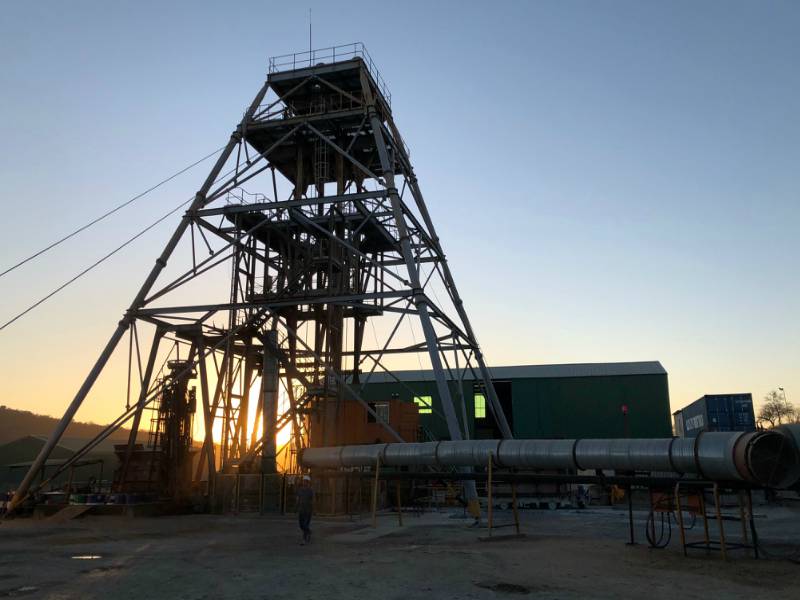Caledonia Mining Corporation plc (LON:CMCL) announced its operating and financial results for the quarter and the six months ended June 30, 2020. Further information on the financial and operating results for the Quarter and First Half can be found in the management discussion and analysis and the un-audited financial statements which are available on the Company’s website and which have been filed on SEDAR.
Financial Highlights for the Quarter
· Gross revenues of $22.9 million, a 39 per cent increase on the $16.5 million achieved in the second quarter of 2019 (“Q2 2019”).
· Gross profit of $9.2 million, a 30 per cent increase on the $7.0 million in Q2 2019 at a gross margin of 40 per cent (Q2 2019, 42.5 per cent).
· EBITDA (excluding net foreign exchange gains) of $9.6 million, a 35 per cent increase on the $7.1 million in Q2 2019 at a margin of 41.9 per cent (Q2 2019, 43.0 per cent).
· On-mine cost of $811 per ounce (Q2 2019, $534 per ounce).
· All-in sustaining cost3 of $868 per ounce (Q2 2019, $656 per ounce).
· Basic IFRS earnings per share (“EPS”) of 43.1 cents (Q2 2019, 210.9 cents).
· Adjusted EPS 3 of 36.8 cents (Q2 2019, 24.6 cents).
· Net cash from operating activities of $4.0 million (Q2 2019, $2.1 million).
· Net cash and cash equivalents of $11.7 million (December 31, 2019, $8.9 million).
· Total dividend paid in the Quarter of 7.5 cents per share; a further dividend at the increased rate of 8.5 cents per share was paid in July.
Operating Highlights
· 13,499 ounces of gold produced in the Quarter (Q2 2019, 12,712 ounces); 27,732 ounces produced in the First Half (first half of 2019, 24,660 ounces).
· Tonnes mined and milled in the Quarter increased by 5 per cent compared to Q2 2019; grade and recoveries were also slightly improved.
· Improved safety performance due to intensive management intervention.
· Equipping of Central Shaft continued in the Quarter.
Effect of COVID-19 and Outlook
· COVID 19 had a negligible effect on production in the Quarter. Production continued at approximately 93% of target during the three-week lockdown which started in Zimbabwe on March 30, 2020; production subsequently returned to above-normal levels and production for the Quarter was only 1.2% below target but was above target for the First Half of 2020. Production guidance for 2020 remains unchanged at 53,000 to 56,000 ounces.
· Progress on the Central Shaft continued, but at a slower pace due to a reduced contractor team. If current travel and transport restrictions continue, delays in sourcing specialist contractors and equipment may delay the completion of Central Shaft.
· Blanket has made substantial contributions of $1,048,000 to the in-country fight against COVID-19 in addition to incremental production costs of $509,000 which were directly related to COVID-19.
· All-in sustaining costs for the Quarter excluding COVID-19 related production costs were $831 per ounce.
· On-track to achieve on-mine cost guidance for 2020 of between $693 to $767 per ounce and all-in sustaining cost guidance of between $951 to $1,033 per ounce.
· Caledonia’s April dividend of 7.5 cents per share was deferred and was paid in May 2020 when management had ascertained the negligible effect of COVID-19 on operations. The July dividend was increased by 13.3 per cent to 8.5 cents per share following the continued strong financial and operating performance. Further dividends will depend upon, inter alia, Blanket maintaining production, while also considering the balance between delivering returns to shareholders and pursuing the significant growth opportunities within Zimbabwe.
Caledonia will be hosting an online presentation and Q&A session open to all investors on Thursday the 13th of August 2020 at 16:00 UK time (17:00 South Africa/Zimbabwe, 11:00AM ET, 08:00AM Pacific Time).
Dial in numbers:
New York +1 212 999 6659
South Africa Toll Free 0800 980 512
Standard International Access +44 (0) 20 3003 2666
UK Toll Free 0808 109 0700
USA Toll Free +1 866 966 5335
Call Password Caledonia Mining Results
Steve Curtis, Caledonia Mining Chief Executive Officer, commented:
“I am delighted by Blanket Mine’s continued strong financial and operating performance in the second quarter of 2020. The management initiatives which were implemented in 2019 have continued into 2020 and have resulted in a 12.4 per cent increase in gold production in the first six months of 2020 compared to the same period of 2019. This continued improvement is despite the challenges we encountered as a result of the COVID-19 pandemic: production in the initial 3-week lockdown in early April was 7 per cent below target but was better than planned in the remainder of the Quarter. Therefore, production for the entire Quarter was only 1.2 per cent below plan; production for the first six months of 2020 was 2.5 per cent above plan. This trend has continued into July with July’s production also exceeding expectations. The resilience of Blanket’s operations during this difficult period is testament to the outstanding commitment of the entire team at Blanket Mine. We therefore remain on track to achieve our production guidance for 2020 of between 53,000 and 56,000 ounces of gold.
“Cost control in the quarter continued to be excellent, but a comparison of the costs for the Quarter to costs in the second quarter of 2019 is complicated by special factors which reduced the costs in previous quarters and increased the costs in this Quarter. The on-mine cost per ounce in the Quarter was $811 compared to $534 in Q2 of 2019. However, the costs in Q2 2019 benefitted from the devaluation of the Zimbabwe dollar which reduced the cost of electricity in that quarter to an artificially and unsustainably low level: the electricity cost in Q2 2019 was only $447,000 compared to an average quarterly cost of approximately $2.3 million in the five preceding quarters. Production costs in the Quarter were adversely affected by, inter alia, $509,000 relating to the COVID-19 pandemic and $871,000 relating to increased maintenance costs of the fleet of trackless mining equipment. Notwithstanding these and other factors, we remain on track to achieve our cost guidance for 2020 of between $693 and $767 per ounce for on-mine costs and between $951 and $1,033 per ounce for all-in sustaining costs.
“The excellent performance was also reflected in continued strong cash generation: net cash flow from operating activities (i.e. before interest, taxation payments and capital expenditure) was $4.0 million in the Quarter compared to $2.1 million in Q2 of 2019. Caledonia ended the Quarter with net cash and cash equivalents of $11.7 million (excluding $1 million of a gold ETF which we purchased in the Quarter to protect cash in South Africa against devaluation of the South African Rand).
“The continued strong performance was achieved without compromising on safety performance. The Total Injury Frequency Rate has been substantially reduced from the levels in 2019 after a concerted effort by management over the last 18 months to improve and enforce safety standards.
“The improved operating environment, which I have referred to in previous quarters, has been sustained, although the country continues to face challenges. The interbank foreign exchange market was suspended in March 2020 but, by the end of June, an equivalent mechanism was introduced as a result of which the local currency has devalued further and allows us to better protect our workers from the effects of high inflation.
“Interruptions to the supply of electricity from the grid have continued, but Blanket can manage these using its increased suite of diesel generators. We have completed an evaluation of a solar project to provide some of Blanket’s power supply and reduce its dependence on imported power and diesel gensets during daylight hours. The Company has now resolved to construct a 12MW solar plant at a cost of approximately $12 million, which is expected to provide 100% of Blanket’s baseload electricity demand during daylight hours and approximately 27% of Blanket’s total daily electricity demand. Whilst expected to deliver an acceptable financial return, this investment is primarily intended to protect Blanket from a further deterioration in its electricity supply. Subject to the continuation of travel and transport restrictions arising from the COVID-19 pandemic, this project could be operational by mid-2021.
“The coronavirus pandemic had no appreciable effect on Blanket’s production in the Quarter. However, work on Central Shaft has been slower than planned because several members of the supervisory team returned to South Africa when the lockdown started in late March. Due to continued travel restrictions, it has not been possible to replace these team members. Although the slower rate of work has not yet delayed the project significantly, the project requires specialised equipment and contractors to travel to Blanket from South Africa which under the restrictions is not currently possible. We are receiving a high level of support from the Zimbabwe government to address these issues with the relevant authorities in South Africa. It is not possible to predict when travel and other restrictions will be lifted so that work can resume on the project as planned and it is likely the timetable for commissioning of the Central Shaft will be extended to an indeterminate extent. This may affect the anticipated build-up in production which is currently expected to be 75,000 ounces of gold in 2021 and 80,000 ounces of gold from 2022 onwards4 but it is not currently possible to provide revised guidance.
“In light of the improved performance and the brighter outlook for 2020 and beyond, Caledonia increased its quarterly dividend from 6.875 cents per share to 7.5 cents per share in January 2020. At the end of June, in light of Blanket’s strong performance, the higher gold price and the return to normal levels of production including renewed access to supply chains, Caledonia increased its quarterly dividend further to 8.5 cents per share which means the cumulative increase in the quarterly dividend in 2020 is 23.6 per cent. The board will review Caledonia’s future dividend distributions as appropriate while considering the balance between delivering returns to shareholders and pursuing the significant growth opportunities within Zimbabwe and in line with a prudent approach to financial management.”
1.Gross profit is after deducting royalties, production costs and depreciation but before administrative expenses, other income, interest and finance charges and taxation.
2.EBITDA is after deducting royalties, production costs and administrative expenses, but is before depreciation, net other income, profit on sale of a subsidiary, net foreign exchange gains, cash-settled share-based payments, hedging expenses, finance charges and taxation.
3. Non-IFRS measures such as “On-mine cost per ounce”, “all-in sustaining cost” and “adjusted EPS” are used throughout this announcement. Refer to section 10 of the MD&A for a discussion of non-IFRS measures.
4. The projected gold production figures in this news release are explained in the management discussion and analysis (“MD&A”) dated March 17, 2020. Refer to technical report dated 13 February 2018 entitled “National Instrument 43-101 Technical Report on the Blanket Mine, Gwanda Area, Zimbabwe (Updated February 2018), a copy of which was filed by the Company on SEDAR on March 2, 2018 for the key assumptions, parameters, and methods used to estimate the mineral resources and mineral reserves from which planned gold production, as set out in this news release, is to be derived and risks that could materially affect the potential development of the mineral resources or mineral reserves. Mr Paul Matthews, the Company’s qualified person and Group Mineral Resource Manager, supervised the preparation of the technical information in the technical report and supervised the preparation of the technical information contained in this news release.








































